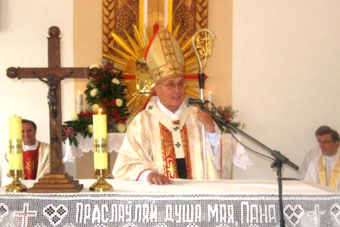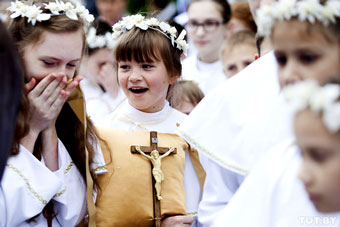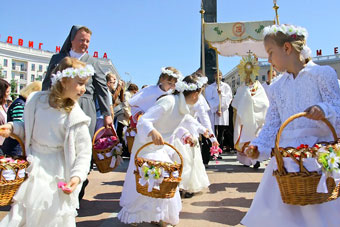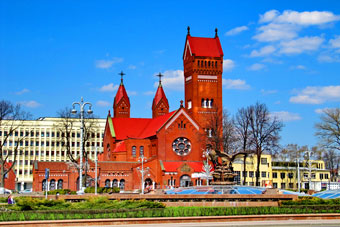Catholicism in Belarus
Christianity is the largest world religion, based on the life and teachings of Jesus Christ, which are described in the New Testament. Christianity arose in the 1st century AD in Palestine. Christians believe that Jesus of Nazareth is the Messiah, the Son of God and the Savior of mankind. The holy book in Christianity is the Bible, collection of texts of the Old and New Testaments. Christianity is divided into several directions: Catholicism, Orthodoxy, Protestantism.
Catholicism is the largest trend in the Christian faith, whose adherents are more than 1.25 billion people. The formation of the institution of the Catholic Church took place during the I millennium AD on the territory of the Western Roman Empire. The Catholic Church considers to be the only church whose founder and head is Jesus Christ himself. The earthly vicar of Jesus Christ is the Pope, who heads the Holy See and the Vatican. Catholic doctrine is based on Holy Scripture and Sacred Tradition. The Sacred Tradition consists of the canons - the code of rules of the Apostles and Ecumenical Councils, liturgical texts, theological creations of the Fathers of the Church, the lives of the saints, and the customs of the church. Catholicism proclaims that there is one God in three forms: God the Father, God the Son (Jesus Christ) and God the Holy Spirit. There are seven sacraments in Catholicism: baptism, church marriage, chrismation, eucharist (communion), confession, anointing, priesthood.
On the lands of Belarus, Latin-Christianity was known from the 10th-11th centuries. According to historians, in 986, the Icelandic missionary Torvald the Traveler arrived in Polotsk and founded a temple in the city, and the monastery of St. John the Baptist. And already in 1005 in Turov, Prince Svyatopolk founded a church.




Catholicism began to spread on the Belarusian lands in the late 14th century. To connection with the fact that the Grand Lithuanian prince Jagiello took Catholicism in order to marry the queen of Poland and to receive the Polish crown. Over time, a significant part of the gentry moved to Catholicism, while the majority of the population remained Orthodox. After the conclusion of the Brest Union in 1596, between the Orthodox and Catholic churches, there was an increase in the list of privileges for Catholics, because their number has increased significantly. A certain role in this was played by the fact that in the 16th - 17th centuries, the Jesuit order appeared on the territory of the Grand Duchy of Lithuania. The Jesuits opened schools in which children belonging to different denominations could receive a quality education. Also the Order was engaged in missionary activity, organized public speeches and debates on religious topics, theatrical productions. By the end of the 18th century, the number of Catholics was about 38% of the population. Approximately 38% were Orthodox.
After Belarus became part of the USSR, an active struggle with religion began in the country including with the Catholicism. Church utensils and property were massively confiscated in favor of the state, and the clergy was subjected to harassment and criminal punishments. On the territory of Western Belarus, which was a part of Poland before 1939, the Catholic Church on the contrary held a high position. Temples, previously transferred to the Orthodox, were re-consecrated back to the churches and returned to the believers. Work was to translate the Bible into Belarusian.
After the unification of Belarus and the end of the Second World War, the policy of combating religion continued in the USSR. After the collapse of the USSR in 1991, the churches and parishes began to open massively. Today, in Belarus, the Catholic Church is the second in terms of the number of believers. According to the Belarusian Catholic Church, about 1.5 million Belarusians consider to be Catholics, which is 15% of the total population. The overwhelming majority of believers live in the western part of the country, despite the fact that Catholic parishes exist throughout the country.
In Belarus, many churches of different epochs have been preserved. Among them: the main Catholic church of Belarus Archcathedral of the Name of the Blessed Virgin Mary. The church is an architectural monument of the 16th-18th centuries, former central element, in the ensemble complex of the Jesuit collegium. In 1798, the church was re-ordained and given to Catholics. It's also worth to pay attention to Grodno Catholic church of Francis Xavier. The church is a monument of architecture of the 16th -17th centuries. The cathedral is built in the style of the Vilna Baroque. The Neo-Gothic Church of Simeon and Helena is located in Minsk. A copy of the Shroud of Turin, donated to the Belarusian Catholics of the Vatican, is kept in the Red Church. An excellent monument of architecture of the early baroque is Catholic church of the Body of God in Nesvizh. Cathedral church, built in the late 16th century by the Italian architect Giovanni Maria Bernardoni, is also the family burial-vault of the magnate family of Razdzivil.
You can get more acquaintanted with the traditions of Catholicism and the history of its development on the territory of Belarus visiting our excursions:
- Belarusian mosaic. During the tour you will see the Church of St. Michael the Archangel of the Renaissance style in Smorgon, in Solah you will see the most unusual church of Belarus the Church of the Virgin Maria Ruzhantsova and the tour will end with sightseeing of the wonderful Neo-Gothic Trinity Church in Gervyaty.
- Choosing the tour Mir-Nesvizh you will get acquainted with the unique monuments included in the list of UNESCO World Heritage - Mir CastleMir Castle and Nesvizh Palace, Catholic church of the Body of God.
- After going on a guided tour of Budslav-Glubokoe-Mosar you will visit the pilgrimage center of hundreds of believers from Belarus, Russia, Ukraine, Poland, Lithuania and Latvia. It's the famous Bernardine church in Budslav. Also you can see the unique icon of the Mother of God of Budslav. In Glubokoe you will get acquainted with the Trinity Church of the 16th-17th centuries, and in Mosar you will be surprised by the monument of architecture of classicism - the church of St. Anne.
You can order these ones and other excursions on religious topics, get acquainted with the culture and traditions of Belarusian Catholics by ordering an excursion on our portal: Request for tour organization
